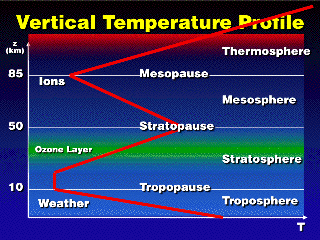 The atmospheric temperature changes with altitude as shown here. From
the ground up to about 10-15 km, the temperature decreases with increasing altitude.
The trend then reverses up to about 50 km, reverses back up to about 85 km,
then goes and increases with altitude nearly to the top of the atmosphere somewhere
between 100 and 500 km (there is no definite top becasue the gases gradually
fade away).
The atmospheric temperature changes with altitude as shown here. From
the ground up to about 10-15 km, the temperature decreases with increasing altitude.
The trend then reverses up to about 50 km, reverses back up to about 85 km,
then goes and increases with altitude nearly to the top of the atmosphere somewhere
between 100 and 500 km (there is no definite top becasue the gases gradually
fade away).
Each of these changes of temperature
trend constitutes a particular layer of atmosphere. The diagram shows some of
the significant features found in each layer. Not illustrated is the ionosphere,
which is located in the mesosphere and thermosphere.
The atmospheric temperature changes
the way it does due to the presence of heat sources. Where there is heating,
there should be higher temperatures. The ground absorbs sunlight and heats up,
producing the relatively high temperatures in the lower part of the troposphere.
The temperature would simply have kept decreasing with increasing altitude if
it wasn't for the ozone layer in the stratosphere,
which heats up when it absorbs ultraviolet radiation from the sun. The mesosphere
has no heat sources, so the temperature decreases with height again. The thermosphere
absorbs a lot of the short wavelength sunlight, and has few molecules, which
results in extremely high temperatures. In fact, near the top the thermosphere,
which receives full strength sunlight, the temperature is probably thousands
of degrees Fahrenheit.
Between each layer, there is an interface
called a pause. The name of the particular "pause" is taken
from the layer immediately below.
Although there are gases all the
way out to 100 to 500 km, those outer layers have very little density. Most
of the atmospheric gas molecules are concentrated in the troposphere (nearly 90% of
the total atmospheric mass is located below 15 km altitude) and the stratosphere (about 9% of the total atmosphere).
The relatively high concentration of gas in the lower atmosphere is due to the compression of
that part of the atmosphere by the weight of the atmosphere above.



 The atmospheric temperature changes with altitude as shown here. From
the ground up to about 10-15 km, the temperature decreases with increasing altitude.
The trend then reverses up to about 50 km, reverses back up to about 85 km,
then goes and increases with altitude nearly to the top of the atmosphere somewhere
between 100 and 500 km (there is no definite top becasue the gases gradually
fade away).
The atmospheric temperature changes with altitude as shown here. From
the ground up to about 10-15 km, the temperature decreases with increasing altitude.
The trend then reverses up to about 50 km, reverses back up to about 85 km,
then goes and increases with altitude nearly to the top of the atmosphere somewhere
between 100 and 500 km (there is no definite top becasue the gases gradually
fade away).